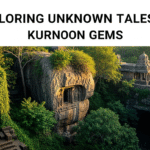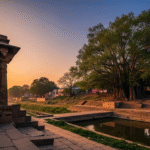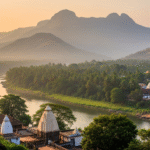India is filled with old caves, each telling a mysterious story of the past. The Karsamble Caves are truly remarkable. They were made long ago, from the 2nd century BCE to the 6th century CE. Even without much decoration, they are grand because they’ve lasted so long.
About 25 caves make up this ancient site. They were places where people lived, prayed, and found peace. Sacred halls and quiet living spaces show how people once lived and worshipped here. The hand-carved details tell the story of India’s rich culture and shared spaces from ages ago.
Stories are carved into the very walls of these caves. As we explore, we dive deep into the beauty and importance of these ancient creations. They guard the spiritual and artistic stories of times long past.
Places like the Ajanta and Ellora Caves are even recognized worldwide as UNESCO World Heritage sites. This shows that India’s caves are more than just natural wonders. They are key chapters in a long, fascinating story that continues to enchant and teach us.
Key Takeaways
- The Karsamble Caves exemplify simplicity and functionality in ancient cave architecture.
- India’s famous Indian caves are pillars of spiritual heritage and rock-cut artistry.
- The chaitya halls and viharas indicate the religious and communal aspects of cave design.
- The Ajanta and Ellora Caves are hallmarks of the rich archaeological sites in India.
- Ancient Indian caves provide a four-dimensional narrative of India’s cultural heritage.
- Understanding these caves deepens our appreciation for India’s historical diversities and intricacies.
Unlocking the Secrets of Karsamble Caves
The Karsamble Caves are in Maharashtra. They show the beautiful history of historical caves in India. These caves were made between the 2nd century BCE and the 6th century CE. They are great examples of ancient craftsmanship. The caves mix Buddhist, Hindu, and Jain cultures. This mix has shaped the area.
Historical Context and Religious Influences
The Karsamble Caves started because of India’s mixed religions and cultures. They are peaceful and beautifully made. The caves are touched by Buddhist architecture and Hindu and Jain influences. This mix has made the caves a place of religious peace and art growth.
Rock-Cut Architecture and Artisan Craftsmanship
The Karsamble Caves are amazing rock-cut caves in India. Skilled artisans carved the hard basalt rock into beautiful holy places. The careful carving shows the era’s tech skills. It also shows the craftsmen’s deep respect for religion and art.
Chaitya Halls and Viharas: Functions and Features
The Karsamble Caves were smartly designed for monks and rituals. The chaitya halls have vaulted roofs and detailed stupas. They were used for group prayers and meditation. Next to these were the viharas or living spaces for monks. They were for shelter and spiritual growth. These areas were important for the monks and seekers living there.
In conclusion, the Karsamble Caves tell India’s rich history of religion and culture mixing. They help us understand the influences that shaped the area’s history and religion.
The Guna Caves: Nature’s Art and Human Legends
The Guna Caves are hidden in Kodaikanal, Tamil Nadu. They attract adventure lovers with their mystery and beauty. Known as Devil’s Kitchen and Pandava Caves, they spark legends of the Mahabharata.
The walk to the Guna Caves is beautiful, with old trees and green forest around. The ‘Khooni Jheel’ adds mystery with its stories of battles. The Indian cave paintings tell tales of India’s history and natural wonders.
Many events have happened here, like the Tamil movie ‘Guna’ being filmed. Sadly, some explorers got lost, leading to debates on safety. Yet, people still come to see them from a safe distance.
The safety rules haven’t stopped people from loving the Guna Caves. They stand near huge rocks, offering a special experience. You can’t go in, but the view is still amazing. It shows nature’s beauty and history together.
The best times to visit are from April to June and August to September. Even with its sad history, the caves’ beauty and legends touch everyone. They are a top place to see in Kodaikanal.
Deciphering the Art and Murals of Ancient Caves
The rock-cut marvels in India connect the physical and spiritual worlds. They are home to some of the oldest art by humans. These ancient cave paintings show how early people lived, what they believed, and their culture. The symbolism in these murals tells stories of spiritual and daily life.
In Haryana’s Mangar Bani hill forest, there are cave paintings about 10,000 years old. This makes them the biggest collection in the Indian subcontinent. They show ancient India’s art through colorful scenes of daily life and spiritual rituals. These paintings are more than decorations. They are historical records of that time.
Iconography and Symbolism in Indian Cave Paintings
The cave paintings include simple shapes, animals, and detailed stories of social events and hunts. Each one shows how ancient people lived. They use symbols to share ideas. For example, fertility rites in Bhimbetka’s caves and spiritual lessons in Ajanta and Ellora’s murals.
Environmental Narratives Captured in Stone
The Odisha rock art sites show early artistic talent and environmental awareness. They depict local plants and animals. This shows how communities lived closely with nature. They respected the natural world. The art styles and themes changed over time. This shows how people’s relationship with their environment evolved.
The variety of Indian cave paintings from Tamil Nadu to Maharashtra shows a rich history of art. Caves like Ajanta and Ellora hold the legacies of their times. They connect history with spirituality through their art and architecture.
The UNESCO World Heritage Caves: Ajanta and Ellora
The Ajanta and Ellora Caves are special places in India. They show the best of old cave temples. These caves let us see into the past. They show us old religions and art.
The Ajanta Caves are famous for beautiful wall art and statues. This art took 800 years to make. There are 30 caves here. People who followed Buddhism made them. They show Buddhism’s history through art.
The Ellora Caves tell us more about Indian rock-cut buildings. They include ideas from three religions. There are 34 temples. One, the Kailasa temple, is very big. It shows great skill in building.
The art in the Ajanta Caves has influenced places far from India. Both cave groups show us old times. They help us understand Indian art and buildings.
Today, India takes care of these caves. The government makes sure they stay safe. They are important for history and tourism. The Ellora Caves show a lot of history from AD 600 to 1000.
The Ajanta and Ellora Caves are very important. They show old Indian religion and building skills. People from all over come to learn and see them. They are treasures of history and spirituality.
Ancient caves in India: A Journey Through Time
The cave temples and monasteries across India are very special. They show India’s spiritual history and stunning rock-cut art. These sites tell stories of ancient Indian life. They are ancient doorways that amaze everyone today.
Era-Defining Cave Temples and Monasteries
In India, cave temples have evolved over thousands of years. Places like Ajanta and Ellora show this change. They started with Buddhist designs and later included Jain and Hindu gods. These amazing places show the ancient Indians’ skills and faith.
Archaeological Revelations and Preservation Efforts
Keeping ancient sites safe is very important in archaeology. This ensures we keep these treasures safe for the future. Teams work hard to keep these places real and safe. Their goal is to protect these glimpses of ancient India.
| Era | Locations | Dominant Religion | Attributed Dynasties |
|---|---|---|---|
| 2nd Century BC – 4th Century AD | Kanheri, Bhaje, Bedse, Karla, Pitalkhora, Ajanta | Buddhism | Satavahanas |
| 5th Century AD – 10th Century AD | Ellora, Elephanta, Kharosa, Aurangabad | Buddhism, Jainism, Hinduism | Vakataks, Rashtrakutas |
Thanks to great care and help from around the world, places like Ajanta and Ellora are safe. They are celebrated globally as UNESCO World Heritage Sites. Taking care of these sites helps us learn about our past. It keeps India’s archaeological stories alive.
The Interplay of Light and Shadow in Rock-Cut Caves
India’s rock-cut caves show both awesome ancient skills and a deep light and shadow play. The strategic openings bring light in. This light dances on the art carved into the walls. It changes the look of sculptures and murals as the day goes on.
Exploring these caves means seeing how light moves inside them. This light leads visitors through, showing the thoughts of ancient builders. These caves blend art and spiritual light. They are rooted in old religious ways.
| Location | Number of Caves | Historical Period | Main Deity/Spiritual Figure |
|---|---|---|---|
| Ajanta Caves, Maharashtra | 29 | 2nd century BCE – 5th century CE | Buddhist Themes |
| Ellora Caves, Maharashtra | 34 | 6th-9th century CE | Multi-faith (Hinduism, Buddhism, Jainism) |
| Udayagiri Caves, Odisha | Jain Cave Architecture Specified | 1st-2nd century BCE | Jain Tirthankaras |
| Badami Cave Temples, Karnataka | 4 | 6th-8th century AD | Lord Shiva and Vishnu |
Visiting these sites is more than seeing ancient caves. It’s feeling an atmosphere made with light and shadow. This method shows the high skill of ancient cave makers.

Mysterious Caves of India: Myths and Realities
The mysterious caves of India have always grabbed attention. They blend archaeological evidence and cave legends. This mix tells us about India’s rich heritage. These caves are full of myths and truths. They show us the beauty of India’s past.
In Patal Bhuvaneshwar, Uttarakhand, Mahabharata tales live on. Adi Shankaracharya found it in 1191 AD. It’s linked to Mt. Kailash, making it very special to many people.
Folklore and Legend versus Archaeological Evidence
Myth and history often mix in exciting ways. Take Ellora’s Kailasa Temple for instance. Its huge scale is as amazing as the legends about its making. This shows how stories and history can come together beautifully.
Exploring the Lore of Unknown Cave Systems
Lesser-known caves have mysteries that draw people in. These places hold stories that are important to our culture. They tell us about our past and the gods, not just through objects but through stories passed down for generations.
| Feature | Data | Legend Associated |
|---|---|---|
| Elevation above sea level | 1350 meters | Connects earth to the heavenly abode |
| Length of the cave | 160 meters | Pathway to different Yugas |
| Discovery Year | 1191 AD | Discovered by a sage with divine foresight |
| Historical Gates | Randwar, Paapdwar, Dharamdwar, Mokshdwar | Each gate represents life stages leading to salvation |
These caves share stories that mix adventure with science. They spark conversations and interest among people who love history.
Embracing the Solitude: Cave Exploration in India
Cave exploration in India shows ancient civilization and the peace of solitude. It’s both calming and thrilling, offering a unique quietness with nature. Caves like Virupaksha and Guhai Namasivaya are perfect for those seeking peace and reflection.

The stories of these caves add depth to exploring them. The revered Virupaksha Cave has been a spiritual haven since the 1300s. The journey starts near Arunachaleswara Temple, offering beautiful paths to this ancient site.
For seekers and adventurers, climbing to Virupaksha and Skandashram is not just about the physical effort. It’s a chance for introspection. This climb is a beloved adventure in the area, calling to many spelunkers. It blends physical and spiritual exploration into one journey.
The Arunachala caves, totaling 30, are filled with unique stories and spiritual meanings. From popular caves like Virupaksha and Skandashram to hidden gems like the Wedding and Tortoise Caves. Each cave invites you to explore not only the cave but also your inner self.
The Udayagiri Caves add another layer to cave exploration. With incredible carvings and artifacts, they blend archaeology with personal reflection. Features in some caves like cushions make these ancient spaces comfy for today’s explorers.
| Location | Name | Significance | Visitor Experience |
|---|---|---|---|
| Virupaksha | Sri Ramana Maharshi’s Refuge | Spiritual and historical relevance since the 1300s | Introspective solitude, connects deeply with spiritual teachings |
| Skandashram | Ascetic Abode | Lived and wrote “Who am I?” | Quiet solitude, ideal for meditation and spiritual quests |
| Tortoise Cave | Historical Insight | Notable site visited by Sri Ramana | Reflective and less frequented, offers personal exploration |
| Wedding Cave | Secluded Viewpoint | Rarely visited, offers solitude and expansive views | Adventurous climb, suitable for solitude and reflection |
In summary, cave exploration in India is more than just a tourist activity. It’s an adventure and a spiritual journey. It gives a glimpse of the past through serene moments in beautiful nature.
Chronicles of Ancient Cave Temples in India
India’s ancient cave temples hold a deep history and cultural importance. Sites like the Barabar Caves and Ellora complex highlight religious and architectural growth. Each temple shares a peek into past spiritual practices and cultural interactions.
Architectural Innovations and Religious Sanctuaries
These temples showcase major architectural feats. They transformed natural rocks into stunning sanctuaries. For example, the Barabar Caves represent early carving efforts. These methods symbolized stability and spiritual protection.
The Evolution of Spiritual Practices Through Cave Temples
These temples show how spiritual practices evolved. They went from simple to complex, featuring beautiful art. The art shows Hindu, Buddhist, and Jain beliefs. This change reflects the dynamic nature of India’s spirituality.
These caves were key in mingling meditation with group worship. They moved from individual practices in the Barabar Caves to group rituals in places like Ajanta. This shows how they adapted to various beliefs over time.
India’s cave temples tell a story of spiritual and architectural progress. They symbolize the country’s cultural richness and the ongoing bond between nature and spirituality.
Conclusion
Exploring ancient caves in India is like stepping into a different world. It’s a trip full of history and spirituality. These places let us see how amazing ancient Indian civilization was.
The Ajanta and Ellora Caves show us the great skills of ancient artists. The Ajanta Caves have a big wall of rock that is 246 feet tall. This place tells a long story that UNESCO helps to protect.
These special caves were important for religion in early India. For example, cave number 19 at Ajanta shows beautiful Gupta art. The big Kailasa temple in Ellora shows what its builders dreamed of doing. Places like the Mandapeshwar Caves in Mumbai are still important. They show how spiritual places have lasted through time.
Every cave site tells a story. Sites from Barabar Hills’ Sudama Cave to Odisha’s Udayagiri and Kandhagiri caves share many tales. They help us understand India’s diverse history.
Looking after these caves is very important. It helps us remember who we are and where we come from. Keeping these caves safe means future generations can learn from them, too. By looking at these beautiful caves, we learn about the past. We see the hard work of artists long ago.
Keeping these caves safe is our duty. It ensures they will tell their stories for a very long time. These wonderful places teach us about a time when art was made to last forever.
FAQ
What are some of the most famous ancient caves in India?
India’s famous ancient caves include the Ajanta and Ellora Caves. They are UNESCO World Heritage sites. There are also caves like the Karsamble Caves and the Guna Caves that are important.
What is the significance of the Karsamble Caves?
The Karsamble Caves show a mix of Buddhist, Hindu, and Jain designs. They are from between the 2nd century BCE and the 6th century CE. This shows ancient skill in rock-cut architecture.
Are there any cave paintings in India?
Yes, caves like the Ajanta Caves have famous paintings. They show stories from Buddhist and Hindu beliefs. These murals show the talent of ancient artists and tell us about early life.
How have the Ajanta and Ellora Caves contributed to India’s cultural heritage?
The Ajanta and Ellora Caves are key to India’s culture. They show ancient religious unity and artistic skill. Scholars, tourists, and historians find them very interesting.
What is the importance of chaitya halls and viharas in the historical caves of India?
Chaitya halls were for prayer and had stupas inside. Viharas were like monasteries where monks lived and meditated. These places were very important for religious practices long ago.
What efforts are being made to preserve India’s ancient caves?
To preserve these caves, there are studies, conservation projects, and UNESCO’s help. Making people aware of these treasures is also important.
Can visitors explore the Guna Caves in Madhya Pradesh?
People can visit the Guna Caves. But they should be careful and may need advice from locals or experts because these caves are very special.
Are there any myths associated with the ancient caves of India?
Yes, many caves have myths. For example, the Guna Caves are linked to the Mahabharata. Such stories make the caves more interesting.
What role does light play in the architecture of rock-cut caves in India?
Light and shadow are used in these caves to show off the art. It makes the carvings beautiful and has a deeper meaning related to enlightenment.
What types of experiences do cave explorers in India typically seek?
Explorers look for adventures, to learn about history and religion, and to find peace. Exploring these caves connects them to India’s past.
What types of spiritual practices are evident within India’s ancient cave temples?
The caves show many spiritual practices, like Buddhist, Hindu, and Jain rituals. They show how these traditions have changed over time.










